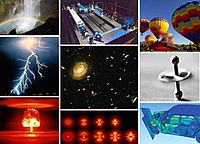
Photo from wikipedia
Complex microstructure changes occur in nuclear fuel and structural materials due to the extreme environments of intense irradiation and high temperature. This paper evaluates the role of the phase field… Click to show full abstract
Complex microstructure changes occur in nuclear fuel and structural materials due to the extreme environments of intense irradiation and high temperature. This paper evaluates the role of the phase field method in predicting the microstructure evolution of irradiated nuclear materials and the impact on their mechanical, thermal, and magnetic properties. The paper starts with an overview of the important physical mechanisms of defect evolution and the significant gaps in simulating microstructure evolution in irradiated nuclear materials. Then, the phase field method is introduced as a powerful and predictive tool and its applications to microstructure and property evolution in irradiated nuclear materials are reviewed. The review shows that (1) Phase field models can correctly describe important phenomena such as spatial-dependent generation, migration, and recombination of defects, radiation-induced dissolution, the Soret effect, strong interfacial energy anisotropy, and elastic interaction; (2) The phase field method can qualitatively and quantitatively simulate two-dimensional and three-dimensional microstructure evolution, including radiation-induced segregation, second phase nucleation, void migration, void and gas bubble superlattice formation, interstitial loop evolution, hydrate formation, and grain growth, and (3) The Phase field method correctly predicts the relationships between microstructures and properties. The final section is dedicated to a discussion of the strengths and limitations of the phase field method, as applied to irradiation effects in nuclear materials.
Journal Title: npj Computational Materials
Year Published: 2017
Link to full text (if available)
Share on Social Media: Sign Up to like & get
recommendations!